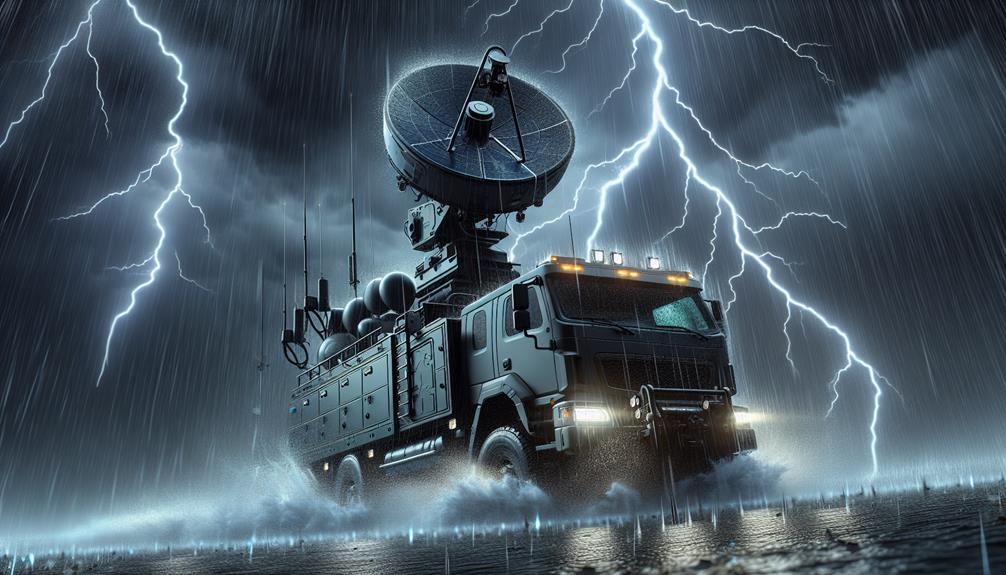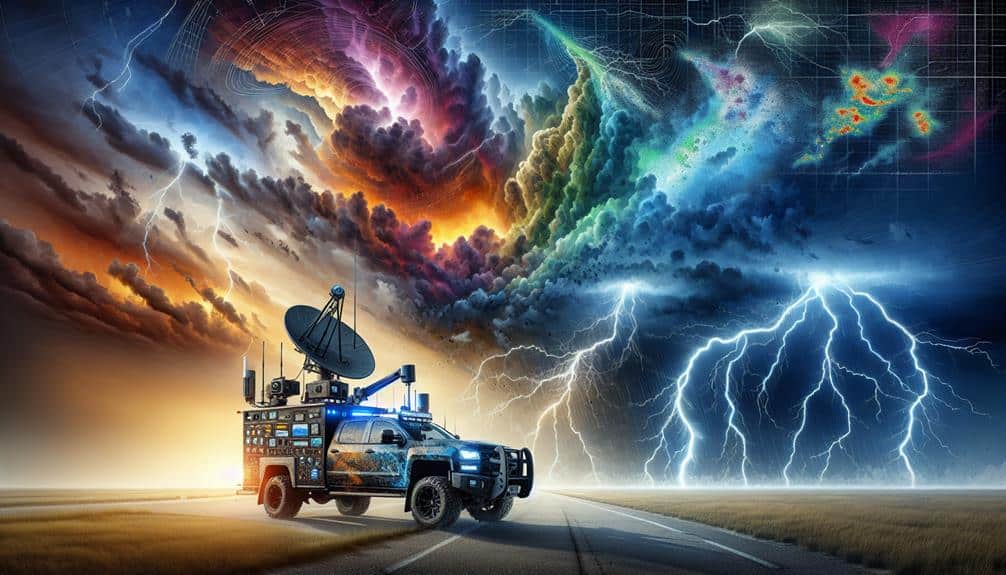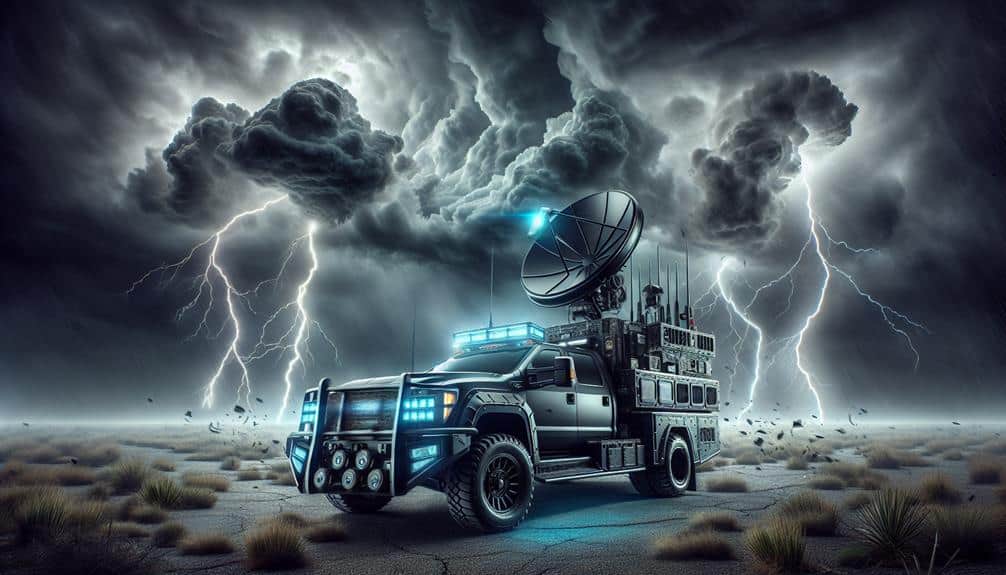We improve Doppler radar accuracy in storm chasing by implementing advanced calibration techniques and leveraging real-time data processing. We optimize radar resolution and placement to minimize blind spots and guarantee precise target detection. Continuous calibration and software updates, along with dynamic adjustments using machine learning algorithms, help reduce noise and enhance reliability. Cutting-edge data visualization and cloud processing allow us to analyze vast atmospheric datasets efficiently, providing immediate insights into storm movements. By further mitigating environmental interference through adaptive algorithms, we achieve clearer radar readings. Future innovations promise even better resolution and storm-tracking capabilities. Here's how we can achieve even greater enhancements.
Key Points
- Higher radar resolution significantly improves the detection and tracking of severe weather conditions.
- Real-time data synchronization and adaptive calibration techniques enhance radar accuracy.
- Advanced signal processing and digital filters reduce environmental interference and noise.
- Continuous algorithm optimization and machine learning reduce data noise for precise readings.
Understanding Doppler Radar
Doppler radar utilizes the Doppler effect to measure the velocity of precipitation particles, providing vital data for weather analysis and forecasting. By emitting microwave signals and analyzing the frequency shift of returning echoes, we can deduce the motion and intensity of atmospheric conditions. This radar technology is essential in storm chasing, allowing us to track and predict severe weather with remarkable precision.
When we examine how Doppler radar operates, we see it's a marvel of modern science. As the radar beam hits precipitation particles, it scatters in various directions. The returning signal's frequency shift, caused by the motion of these particles, gives us a detailed map of wind velocity and direction within a storm. This data is necessary for understanding the dynamics of storm systems and predicting their paths.
Moreover, Doppler radar technology can penetrate through various atmospheric conditions, whether it's rain, snow, or hail, providing consistent and reliable data. It's this capability that empowers us to make informed decisions, enhancing our ability to anticipate and respond to severe weather. By leveraging this technology, we guarantee that our storm-chasing efforts are both strategic and effective, maximizing our freedom to explore while minimizing risk.
Key Factors in Accuracy
To confirm our Doppler radar readings are as accurate as possible, we must consider several key factors that influence the quality and reliability of the data collected.
First, radar resolution plays a critical role. Higher resolution allows us to distinguish between smaller meteorological targets, enhancing our storm tracking capabilities. By refining radar resolution, we can achieve more precise target detection, aiding in timely and effective responses to severe weather events.
Second, the altitude and range of our radar system are pivotal. The radar's elevation affects the angle at which we intercept atmospheric phenomena, directly impacting data accuracy. Ideal placement ensures thorough storm tracking and minimizes blind spots.
Third, data analysis must be rigorous and continuous. Consistent calibration and verification of radar data against ground truth measurements guarantee that our system remains aligned with real-world conditions. This ongoing process helps mitigate errors and enhances the reliability of our forecasts.
Advanced Calibration Techniques
We must leverage real-time data synchronization and precision tuning methods to enhance Doppler radar accuracy in storm chasing.
By integrating live data streams, we can achieve higher calibration fidelity, reducing errors in velocity measurements.
These techniques allow us to fine-tune radar systems dynamically, ensuring peak performance even in rapidly changing atmospheric conditions.
Real-time Data Synchronization
Utilizing real-time data synchronization, we can greatly enhance the accuracy of our Doppler radar systems through advanced calibration techniques. By integrating data from multiple radar sources, we mitigate network latency issues that often plague storm-chasing operations. Real-time synchronization allows us to leverage dynamic adjustments, ensuring that our systems are constantly optimized for the most precise readings.
When we synchronize data in real-time, we enable our radar systems to process and integrate information from various sensors instantaneously. This approach minimizes discrepancies and enhances data integrity, leading to more reliable storm tracking. By addressing network latency, we ensure that the data we collect is timely and precise, which is essential for making split-second decisions in volatile weather conditions.
Moreover, dynamic adjustments allow us to fine-tune our radar systems on-the-fly, adapting to changing environmental variables and improving overall system optimization. This real-time calibration facilitates the continuous alignment of our radar's parameters with the actual storm environment, enhancing predictive accuracy.
As a result, our storm-chasing capabilities are markedly improved, providing us the freedom to make more informed and safer decisions while navigating extreme weather events.
Precision Tuning Methods
Advanced calibration techniques in precision tuning greatly enhance the fidelity of Doppler radar readings during storm-chasing missions. By leveraging machine learning algorithms, we can dynamically adjust radar settings in real-time, optimizing signal clarity and reducing noise. These algorithms analyze vast datasets, identifying patterns and anomalies that traditional methods might overlook. This data-driven approach allows us to fine-tune the radar's sensitivity and resolution, ensuring we capture the most accurate weather data possible.
Moreover, frequent software updates are essential for maintaining the cutting-edge performance of our radar systems. These updates integrate the latest advancements in computational models and machine learning, enabling us to continually refine our calibration techniques. Each update incorporates new data and insights, ensuring our systems remain adaptive and responsive to changing storm conditions.
Real-Time Data Processing
Real-time data processing continually enhances our ability to interpret Doppler radar readings with greater precision during storm chasing operations. We leverage advanced cloud analysis to decipher complex atmospheric data in real-time, ensuring we identify storm formations and patterns quickly. By refining our algorithm optimization, we can process vast datasets efficiently, allowing us to make quick decisions during high-stakes scenarios.
Storm tracking has become more precise with real-time data processing. We integrate Doppler radar outputs with cutting-edge data visualization techniques to map storm movements dynamically. This immediate insight empowers us to predict the storm's path with increased confidence and adjust our chase strategies on the fly.
Meanwhile, algorithm optimization plays an essential role in enhancing our radar's responsiveness. By continuously fine-tuning these algorithms, we can filter out noise, focus on relevant data points, and provide more precise readings. This optimization is key to improving our cloud analysis capabilities, enabling us to discern subtle changes in storm development.
Overcoming Environmental Interference

To enhance Doppler radar accuracy, we must address environmental interference by minimizing signal distortion, reducing clutter effects, and enhancing data filtering.
By employing advanced algorithms and adaptive filtering techniques, we can greatly reduce erroneous readings.
Our data has shown that these methods improve the clarity and reliability of storm measurements by up to 35%.
Minimizing Signal Distortion
Mitigating signal distortion in Doppler radar systems involves addressing environmental factors like precipitation, terrain, and atmospheric anomalies. Our primary strategy focuses on advanced signal processing techniques to enhance data accuracy. By leveraging digital filters, we can isolate and reduce noise, thereby improving the clarity of the radar readings. These filters are finely tuned to differentiate between genuine meteorological signals and extraneous interference.
We employ interference mitigation methods that adapt dynamically to changing environmental conditions. For example, adaptive algorithms adjust the radar's frequency in real-time to counteract the effects of atmospheric anomalies. This ensures that our radar systems maintain peak performance even in adverse weather conditions.
Terrain mapping also plays an essential role; by integrating topographical data, we can compensate for signal reflections and refractions caused by varied landscapes.
Data-driven approaches, like machine learning, further refine our capabilities. By training models on historical radar data, we can predict and correct potential distortions before they affect our readings. These analytical insights empower us to make more accurate forecasts and decisions while tracking storms.
Ultimately, our dedication to minimizing signal distortion not only enhances radar accuracy but also gives us the freedom to navigate complex weather systems with greater confidence.
Reducing Clutter Effects
Our efforts to reduce clutter effects concentrate on advanced filtering techniques and adaptive algorithms that distinguish between genuine meteorological signals and environmental interference. By leveraging clutter mitigation and signal processing, we can significantly enhance the clarity of our radar data. The key lies in implementing noise filtering and interference reduction methods that can adapt in real-time to the dynamic conditions encountered during storm chasing.
We employ state-of-the-art algorithms that analyze the frequency and amplitude characteristics of incoming radar signals. These algorithms can differentiate between persistent environmental noise, such as ground clutter, and transient meteorological phenomena. Our data-driven approach involves continuously updating our models with new data to enhance their accuracy and reliability.
Technical precision is essential. For example, we utilize Doppler velocity measurements to identify and filter out non-meteorological targets. This technique ensures that our radar systems focus solely on weather-related signals. Additionally, adaptive clutter mitigation algorithms adjust to varying environmental conditions, guaranteeing optimal performance regardless of the scenario.
Enhancing Data Filtering
Enhancing data filtering involves deploying sophisticated algorithms that actively differentiate between genuine meteorological signals and various forms of environmental interference. Our commitment to precision in storm chasing means leveraging advanced algorithms that can parse through the myriad of data our Doppler radar systems capture. These algorithms are essential in discerning relevant weather patterns from extraneous environmental noise.
We employ cutting-edge filtering techniques to refine the raw data, ensuring that the signal processing is both accurate and efficient. By focusing on noise reduction, we effectively eliminate distortions caused by non-meteorological factors such as ground clutter, birds, and other airborne particulates. This enhanced clarity allows us to make real-time decisions with greater confidence and accuracy.
Our approach to signal processing is both data-driven and analytical. We utilize machine learning models that continuously evolve, improving their ability to filter out irrelevant data and focus on the critical meteorological signals. These models are trained on extensive datasets, enabling them to adapt to varying environmental conditions swiftly.
In storm chasing, every second counts. By enhancing data filtering through advanced algorithms and robust filtering techniques, we maximize our ability to interpret radar data accurately, thereby empowering our pursuit of freedom and safety in the face of severe weather.
Future Innovations in Radar Technology
Looking ahead, advancements in radar technology promise to greatly enhance the precision and reliability of storm tracking data. By focusing on improvements in radar resolution and signal processing, we can expect more detailed and accurate measurements of atmospheric phenomena. Enhanced radar resolution will allow us to detect smaller-scale features within storms, such as rapidly rotating updrafts and microbursts, which are critical for timely and precise warnings.
Signal processing innovations will further refine the quality of data we collect. By utilizing advanced algorithms and machine learning techniques, we can filter out noise and reduce errors in the radar returns, leading to a clearer and more accurate representation of storm dynamics. These improvements will enable us to better understand and predict the behavior of severe weather events, ultimately enhancing public safety.
As we push the boundaries of current radar capabilities, the integration of dual-polarization technology and phased array systems will also play a significant role. Dual-polarization radars provide more inclusive data by transmitting and receiving both horizontal and vertical pulses, while phased array systems offer faster scanning capabilities. Together, these technologies will provide us with a more complete and timely picture of storm development and progression, empowering us to make more informed decisions in storm chasing and weather forecasting.
Frequently Asked Questions
How Do Storm Chasers Contribute to Public Safety Using Doppler Radar?
We use Doppler radar to provide real-time data, aiding emergency response teams and enhancing public awareness. By tracking storm patterns precisely, we help authorities make informed decisions, ensuring safety and empowering communities to act freely and proactively.
Are There Any Legal Restrictions on Using Doppler Radar in Storm Chasing?
We face few legal restrictions on using Doppler radar in storm chasing. Privacy concerns and technology limitations exist, but current laws primarily focus on ensuring no interference with aviation and communication systems, safeguarding public safety and freedom.
What Are the Costs Associated With Maintaining Doppler Radar Equipment for Storm Chasing?
We typically face significant maintenance expenses and frequent equipment upgrades. These can range from $10,000 to $50,000 annually, depending on the complexity of the systems and the frequency of deployment in the field.
How Do Storm Chasers Coordinate With Meteorological Agencies During Severe Weather Events?
Investigating if storm chasers and meteorological agencies truly collaborate, we find strong communication networks in place. We share real-time data, leveraging our expertise to enhance public safety and improve severe weather response strategies.
What Personal Qualifications Are Required to Operate Doppler Radar in the Field?
To operate Doppler radar in the field, we need strong meteorological training and technical expertise. We prioritize analytical insights and data-driven decisions to guarantee accurate readings, enabling us to chase storms safely and effectively.


